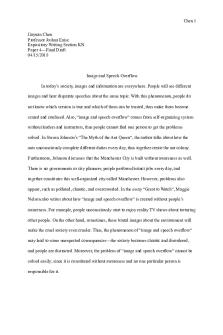Bus510 final 4 PDF

| Title | Bus510 final 4 |
|---|---|
| Course | Business Analytics and Decision Modeling |
| Institution | The Pennsylvania State University |
| Pages | 3 |
| File Size | 35.5 KB |
| File Type | |
| Total Downloads | 94 |
| Total Views | 156 |
Summary
BUS 510 final study guide...
Description
usability
- the degree to which a system is easy to learn and efficient and satisfying to use serviceability
- how quickly a third party can change a system to ensure it meets user needs and the terms of any contracts, including agreed levels of reliability, maintainability, or availability Moore's law
- computer chip performance per dollar doubles every 18 months sustainable or green MIS
- describes the production, management, use, and disposal of technology in a way that minimizes damage to the environment corporate social responsiblity
- companies' acknowledged responsibility to society Ewaste
- refers to discarded, obsolete, or broken electronic devices sustainable MIS disposal
- refers to the safe disposal of MIS assets at the end of their life cycle energy consumption
- the amount of energy consumed by business processes and systems carbon emissions
- the carbon dioxide and carbon monoxide produced by business processes and systems grid computing
- collection of computers, often geographically dispersed, that are coordinated to solve a common problem smart grid
- delivers electricity using two way digital technology virtualization creates multiple "virtual" machines on a single computing device data center
- facility used to house management information systems and associated components, such as telecommunications and storage systems cloud computing
- a model for enabling ubiquitous, convenient, on-demand network access to a shared pool of configurable computing resources that can be rapidly provisioned and released with minimal management effort or service provider interaction multi-tenancy in the cloud
- a single instance of a system serves multiple customers! single-tenancy
- each customer or tenant must purchase and maintain an individual system cloud fabric
- the software that makes possible the benefits of cloud computing cloud fabric controller
- individual who monitors and provisions cloud resources, similar to a server administrator at an individual company utility computing
- offers a pay-per-use revenue model similar to a metered service such as gas or electricity Infrastructure as a service (IaaS) - delivers hardware networking capabilities, including the use of servers, networking, and storage, over the cloud using a pay-per-use revenue model dynamic scaling - means the MIS infrastructure can be automatically scaled up or down based on needed requirements software as a service (SaaS) - delivers applications over the cloud using a pay-per-use revenue model Platform as a service (PaaS) - supports the deployment of entire systems including hardware, networking, and applications using a pay-per-use revenue model public cloud - promotes massive, global, and industrywide applications offered to the general public private cloud - serves only one customer or organization and can be located on the customer's premises or off the customer's premises community cloud - serves a specific community with common business models, security requirements, and compliance considerations hybrid cloud - includes two or more private, public, or community clouds, but each cloud remains separate and is only linked by technology that enables data and application portability cloud bursting - when a company uses its own computing infrastructure for normal usage and accesses the cloud when it needs to scale for peak load requirements, ensuring a sudden spike in usage does not result in poor performance or system crashes...
Similar Free PDFs

Bus510 final 4
- 3 Pages

Bus510 final 1
- 2 Pages

Final answers week 4
- 3 Pages

Formal Lab 4 Final
- 6 Pages

Final Assignment 4
- 3 Pages

Final test - 4 - dsfdsfdsd
- 1 Pages

Group 4 Final Project
- 70 Pages

SOC242 Final 4
- 3 Pages

Tp 4 autoevaluacion final
- 9 Pages

Travail 4 psychologie Final
- 8 Pages

Animal Research Final WK 4
- 4 Pages

Music 4 - Final Study Guide
- 7 Pages

Paper 4 Final - Grade: B+
- 6 Pages
Popular Institutions
- Tinajero National High School - Annex
- Politeknik Caltex Riau
- Yokohama City University
- SGT University
- University of Al-Qadisiyah
- Divine Word College of Vigan
- Techniek College Rotterdam
- Universidade de Santiago
- Universiti Teknologi MARA Cawangan Johor Kampus Pasir Gudang
- Poltekkes Kemenkes Yogyakarta
- Baguio City National High School
- Colegio san marcos
- preparatoria uno
- Centro de Bachillerato Tecnológico Industrial y de Servicios No. 107
- Dalian Maritime University
- Quang Trung Secondary School
- Colegio Tecnológico en Informática
- Corporación Regional de Educación Superior
- Grupo CEDVA
- Dar Al Uloom University
- Centro de Estudios Preuniversitarios de la Universidad Nacional de Ingeniería
- 上智大学
- Aakash International School, Nuna Majara
- San Felipe Neri Catholic School
- Kang Chiao International School - New Taipei City
- Misamis Occidental National High School
- Institución Educativa Escuela Normal Juan Ladrilleros
- Kolehiyo ng Pantukan
- Batanes State College
- Instituto Continental
- Sekolah Menengah Kejuruan Kesehatan Kaltara (Tarakan)
- Colegio de La Inmaculada Concepcion - Cebu


